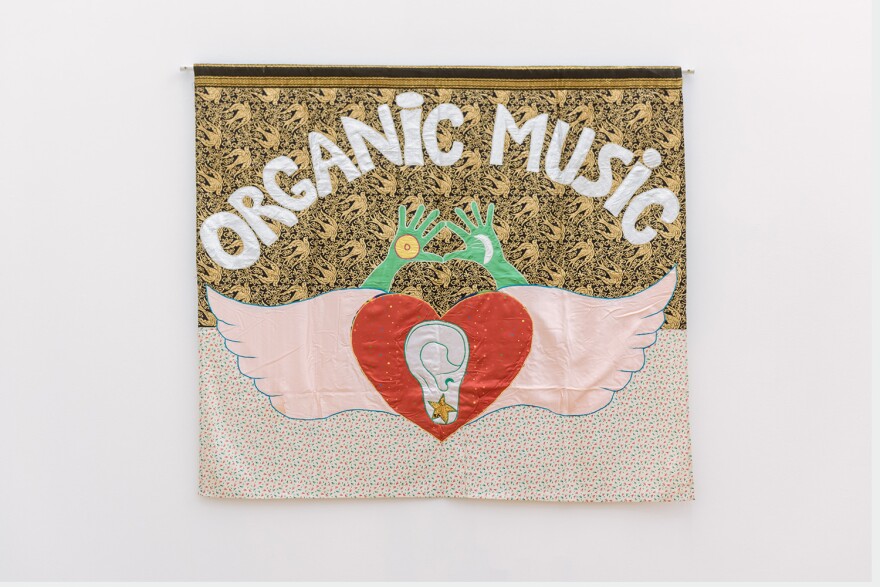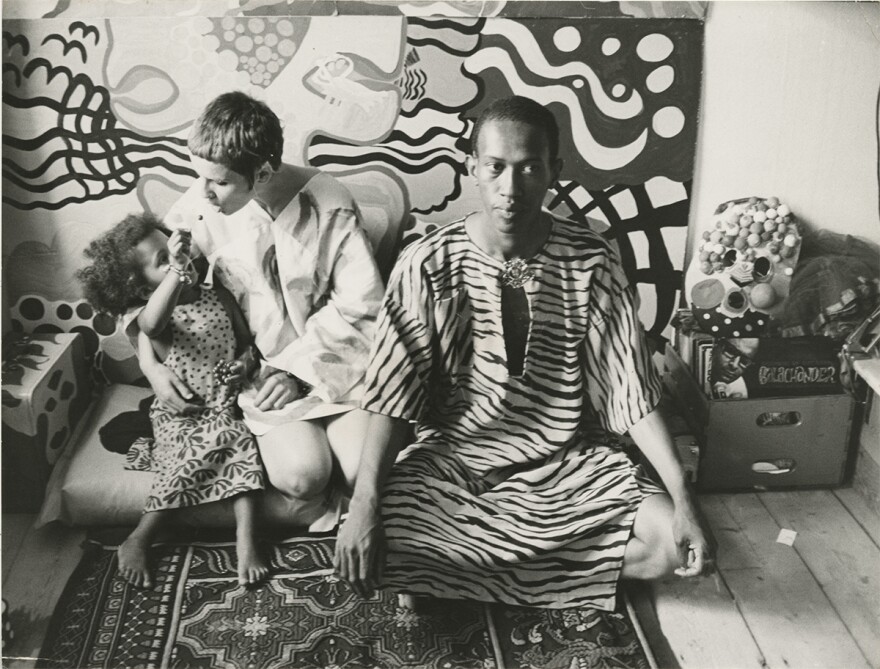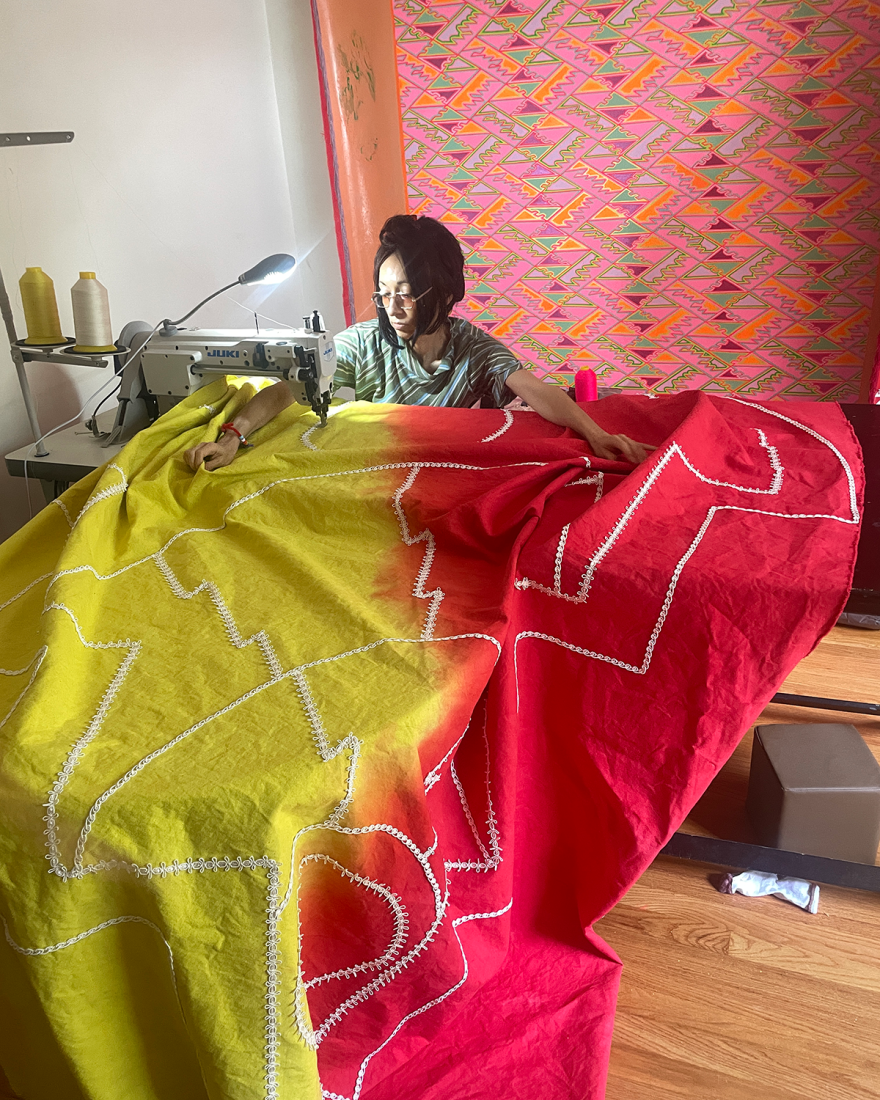The town of Tågarp, Sweden is not necessarily the first place you might think of as the epicenter of an artistic utopia. But that is exactly where Moki and Don Cherry spent more than a decade, beginning in the late 1960s, gathering a community of like-minded artists around their concept of “organic music.”
Their shared vision radiated outward from a former schoolhouse in the Swedish countryside, where they performed, taught, lived, and raised their children – including the future musicians Neneh Cherry and Eagle-Eye Cherry. Life and art, the personal and the professional, were inextricably twined for the pair. As Moki wrote, “The stage is home and home is a stage.”
Her work and contribution to “organic music” are the focus of The Living Temple, a dynamic new exhibit opening later this month at the Fabric Workshop and Museum in partnership with Ars Nova Workshop. The retrospective spans Moki’s life and career, from some of her earliest paintings to the politically focused textile work she was creating prior to her death in 2009.

Ars Nova director Mark Christman, who co-curated the show with Danielle Jackson of Artists Space, New York, says the purpose of The Living Temple is “to look beyond Don. Moki was quite a force, but she was paired up for a lot of her life with another force. That often seduces us and distracts us from her complete story.”
A similar intention lies behind “Remember Brooklyn & Moki,” a track on tenor saxophonist James Brandon Lewis’ recent album Apple Cores, which also includes a tribute to Ornette Coleman’s partner for a decade, poet Jayne Cortez.
“I was fascinated by these women’s achievements that often get overshadowed by their counterparts,” Lewis reflects, in an email. “The intersection between visual art, music and spirituality [that Moki’s] work embodies is the blueprint for what I feel is necessary. Interdisciplinary thinking is key toward true authenticity and innovation.”
Don Cherry’s stature in the jazz pantheon is undeniable. The trumpeter, who died in 1995, made formative contributions to the evolution of avant-garde and free jazz through his lengthy collaboration with Ornette Coleman, and was a pioneering figure in what would come to be loosely known as world music, adopting elements of diverse cultural traditions and finding common ground with fellow musicians from throughout the globe.
Moki Cherry (née Karlsson) was primarily a visual and textile artist and fashion designer. Her work graces the cover of several of Don’s albums, including Organic Music Society, Brown Rice, and Relativity Suite. Yet Don and Moki’s roles are impossible to neatly separate into those of the musician and the designer. Their relationship was such that a constant flow of inspiration circulated from one to the other, and from their mutual experiences into their common expression.

The galleries of the Fabric Workshop were largely empty when I visited earlier this month, with artworks still in crates and boxes, tape marks on the walls indicating where texts will hang, and blank monitors awaiting the footage that will revive Moki and Don’s partnership for visitors. Against the expanse of white, the few artworks that had been unpacked bust forth with bold color: swirling, multi-hued landscapes peopled with hybrid creatures; a tunic fronted with a camel and palm tree; a fantastical visage under the question, “Commmunicate [sic], How?” A copy of Don’s 1977 album Hear & Now rested on a table.
The archway in which he sits cross-legged on the cover appears at first glance to be a painting; it is in reality a set of tapestries created by Moki that will appear in the show in the same configuration. The white brick walls of the eighth-floor gallery will soon be covered by the immense tapestries that the artist created as backdrops for the couple’s Organic Music Theatre performances.
For those familiar with Don’s discography, it is easy to see the multicultural influences and buoyant spiritual uplift of his music reflected in Moki’s work. But being in the presence of the environments that she crafted to frame the music, from clothing to staging, it is equally obvious that Don’s work couldn’t help but be shaped by Moki’s vibrant creations.

The Fabric Workshop’s eighth-floor gallery will also host Talismans for a Theater of Resilience, a new exhibition by the organization’s artist-in-residence, Lisa Alvarado, whose work similarly exists in relation to her work as a member of the band Natural Information Society. Her show will include a pair of large fabric pieces along with window gels and kinetic sound sculptures, all designed to echo the natural cycles of the body, nature, and music. The works will become a stage set for the ensemble when Natural Information Society performs in the gallery on Sunday, Oct. 12.
“The musical performances give new layers of meaning and memory to the works,” Alvarado tells WRTI. “The performances animate the works and the real life gatherings they create give new life to the histories and meanings that the works connect to and convey.”
According to Christman, both exhibitions manifest the philosophy that has spurred the work of Ars Nova Workshop throughout its 25-year existence. Beyond simply presenting performances, these artists embody a holistic philosophy of creativity and improvisation.
“This is an opportunity to support the larger story of this work, these people, the ideas they’ve embraced and the worlds that they’ve created that go beyond an album and a stage,” he says. “My hope is that projects like this can illustrate that these improvisatory practices and tactics can lead to greater good and better worlds.”
The Living Temple: The World of Moki Cherry runs Sept. 25, 2025 through April 12, 2026 at the Fabric Workshop and Museum.


